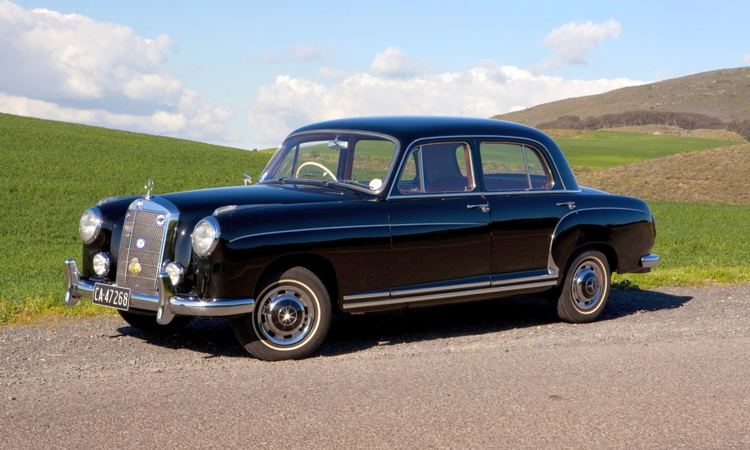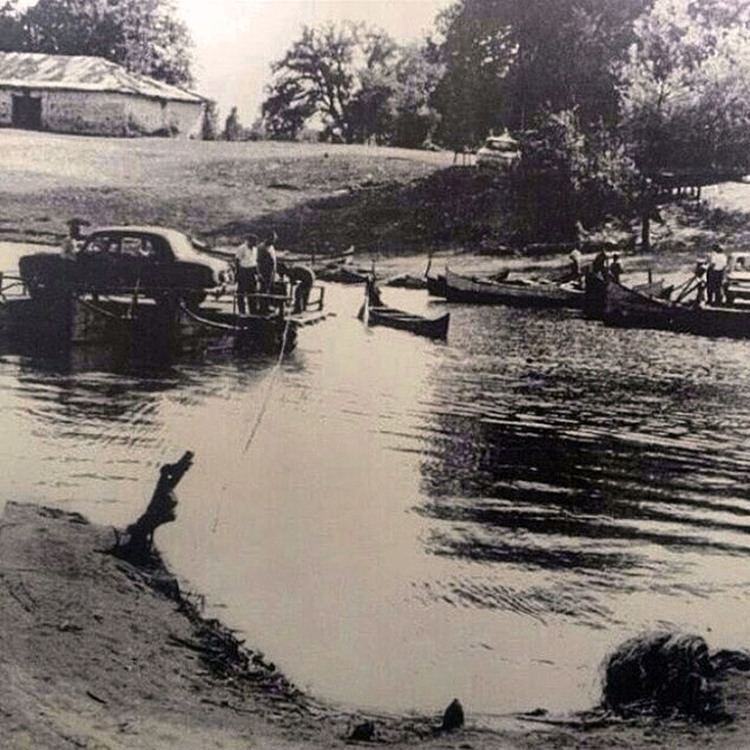 | ||
Ponton or pontoon styling refers to a 1930s–1960s design genre—ultimately the precursor of modern automotive styling. The trend emerged as bodywork began to enclose the full width and uninterrupted length of a car, incorporating previously distinct running boards and fully articulated fenders. The fenders of an automobile with ponton styling may also be called Pontoon fenders, and the overall trend may also be known as envelope styling.
Contents

Now largely archaic, the term Ponton describes the markedly bulbous, slab-sided configuration of postwar European cars, including those of Mercedes-Benz, Opel, Auto Union, DKW, Borgward, Lancia, Fiat, Rover, Renault, and Volvo—as well as similar designs from North America and Japan.

The term derives from the French and German word ponton, meaning 'pontoon'. The Langenscheidt German–English dictionary defines Pontonkarrosserie as "all-enveloping bodywork, straight-through side styling, slab-sided styling."
Origin of the trend

The term ponton styling may have derived from the wartime practice in Germany of adding full-length tread armor along each side of a tank, attached primarily on the top edge—which resembled pontoons. As this roughly coincided with automobile styling trend where bodywork, especially running boards and fenders, became less articulated—with cars carrying integrated front fenders and full-width, full-length bodywork—the design took on the "pontoon" or "ponton" descriptor.
One of the first known cars with a ponton body is the Bugatti Type 32 "Tank" which participated in the 1923 French Grand Prix at Tours.
In 1924, Fidelis Böhler designed one of the first production cars with a ponton body, the Hanomag 2/10. The car's body resembled a loaf of bread earning it the sobriquet of "Kommissbrot"—a coarse whole grain bread as issued by the army. The economical car was produced from 1924 to 1928. Böhler built the core body around two side-by-side passenger seats. He dispensed with running boards and integrated the fenders in the body to save on weight. The inexpensive car became popular with consumers in Germany.
In 1935, Vittorio Jano, working with the brothers Gino and Oscar Jankovitz, created a one-off mid-engine prototype on an Alfa Romeo 6C 2300 chassis, which Jano had shipped to Fiume in 1934. The brothers Jankovitz had been close friends with leading Hungarian aerodynamicist Paul Jaray, and the prototype, called the Alfa Romeo Aerodinamica Spider, featured ponton styling—an especially early and clear example of the bulbous, uninterrupted forms that would come to characterize the genre.
In 1937, Pinin Farina designed a flowing ponton-style body for the Lancia Aprilia berlinetta aerodynamica coupé, and also the open body on the 1940 Lancia Aprilia Cabriolet.
The 1946 Cisitalia 202 coupé, which Farina designed from sketches by Cisitalia’s Giovanni Savonuzzi, was the car that "transformed postwar automobile design" according to New York’s Museum of Modern Art (MoMA). MoMA acquired an example for its permanent collection in 1951, noting that the car’s "hood, body, fenders, and headlights are integral to the continuously flowing surface, rather than added on. Rounded, flowing forms, with unbroken horizontal lines between the fenders—the style had identified as "the so-called Ponton Side Design" became "the new fashion in Europe".
One of the first American cars to adopt the new style was the 1947 Studebaker Champion, designed by Virgil Exner and Roy Cole but sometimes erroneously attributed to Raymond Loewy. Another, the Howard "Dutch" Darrin-designed 1947–1950 Kaiser-Frazer, was said to have been the inspiration for the 1949 Borgward Hansa 1500, Germany's first sedan in the ponton style.
In the Soviet Union the GAZ-M20 Pobeda came into production in 1946, about one month after the first 1946 Kaiser rolled off the production line, and in Britain the Standard Vanguard went on sale the following year. In 1948 Czechoslovakian Tatra 600 began production.
Ford and General Motors followed the trend with their own designs in 1949.
Examples of "ponton" in automotive contexts
One of the earliest completely new styled cars that were introduced after World War II in the United States were the 1949 Nash models. Popular Science magazine described the new "pontoon" Nashes as "the most obvious departure from previous designs." They "carried the fenderless pontoon-body, fast-back shape further than the competition." This Nash design became a "family appearance" for their automobiles that also included the Nash-Healey. The 1952 redesign of the two-seat sports car took on an "even closer family appearance" to the redesigned Nash models by featuring "pontoon-type fenders fore and aft." The new styling also moved the headlights "from the pontoon fenders to the grille."
The term is also used in reference to Mercedes-Benz models from 1953–1962. For example, a book about the marque refers to "the Ponton", the "Ponton saloon", "Ponton 220", "Ponton 220S and SE coupes and cabriolets", and "the Ponton models".
A General Motors document refers to the 1953 Olympia Rekord as "the first Opel with a full-width, or ponton, body shell".
The Volkswagen Beetle carried articulated running boards and fenders, but the subsequent Volkswagen Type 3 became known for its ponton styling; in the Netherlands the Volkswagen Type 3 (1961–1974) 2-door notchback sedan was referred to as the Ponton.
In a reference work on alternative-energy vehicles, electrical-engineering academics used the term as a generic for saloon cars with three-box design; also a 2007 German work on car design and technology mentions a "Rover-Ponton" (ponton-style Rover); and a French book on art and design also used the term in an automotive context in 1996.
Ponton fenders
Pontoon fenders are a type of automobile fender, or "wings" as they are sometimes called in the United Kingdom.
Originally the term referred to a design prevalent in the United States in the 1930s where front fenders encased a wheel and terminated in a teardrop point, remaining distinct from the running boards or the body of the car. Examples include the Cord 810/812, the Auburn Speedster and several designs by French Carrossiers, notably Figoni et Falaschi.
Subsequently the term pontoon fender took on another more prominent definition, derived from the wartime practice in Germany of adding full-length tread armor along each side of a tank, attached primarily on the top edge—and resembling pontoons. As this roughly coincided with automobile styling trend where distinct running boards and articulated fenders became less common—with cars carrying integrated front fenders and full-width, full-length bodywork—the fenders took on the "pontoon fender" nickname.
The postwar trend of the markedly round, slab-sided designs became itself known as ponton styling—with many postwar Mercedes-Benz models informally nicknamed the "Ponton".
The British assumed the latter definition, using it in such works as the Beaulieu National Motor Museum Encyclopedia of the Automobile.
